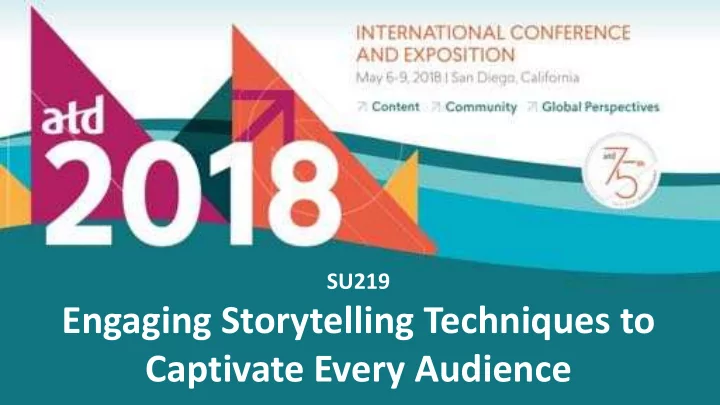

SU219 Engaging Storytelling Techniques to Captivate Every Audience
Get ready to learn: • A brief history of storytelling • Why we tell stories • How to use a road map to select, create, and present your stories • Lots of examples and ideas! #ATD2018 #StorytellingATD
17,000 B.C.: Lascaux Caves, France Source: National Geographic 2500 B.C.: Gilgamesh Source: Wikipedia 8 th Century B.C.: Homer Source: Wikipedia 16 th Century: Shakespeare Source: Wikipedia
Your assignment: Tell a story! Pick any topic, such as: • A work story • The best gift you ever gave • Your favorite memory • A holiday story • A pet story • Your childhood • A story about travel • A story about overcoming fear • Your favorite coworker
Why do we tell stories? • Our brains are hardwired to process information as stories. • Stories use our left and right brains. • We think in narratives.
Why should we use stories in training? • Stories advance learning outcomes. • Stories remind us of “what’s in it for me.” • Stories capture attention. • Stories help us connect learning to our work. • Stories make training human.
Grab your handouts!
Learning Outcomes
Storytelling and Learning Outcomes • Everything should connect back to your learning outcomes- even your stories! • Stories are not just to entertain! • Let your learning outcomes guide the story you select. Learning Outcomes
ILT e-Learning Format Virtual Learning Informal Outcomes
Storytelling and Format: a Crash Course • Your format opens the door to your storytelling options. • Storytelling can be just as powerful in any format. ILT e-Learning Virtual Informal
ILT Audience e-Learning Format Virtual Learning Informal Outcomes
Know Your Audience • Demographic information can help. • Put yourself in their position: • Why are they part of your training? • What make them unique? Audience • Let your audience influence the stories you select.
ILT Audience e-Learning Format Virtual Learning Informal Outcomes Research
Story Research • Whose story will you use? • How can you engage your SMEs? • Consider your learners and the stories they can share. Research
ILT Audience e-Learning Format Virtual Learning Informal Outcomes Draft Story Research
What are the components of a good story? • Great stories are: • How can you tell a great story? • Relatable • Create suspense • Authentic • Bring characters to life • Immersive • Show, don’t tell • Engaging • Use dialogue • Interesting or thought-provoking • End on a positive note Draft Story
Stories should be real! • There is a big difference between “fake” stories and real stories, and learners can tell. • Be aware of your audience. • Keep stories simple. • Be aware of the words you use. Draft Story
ILT Audience e-Learning Format Virtual Learning Informal Outcomes Draft Story Develop Story Research
Bring your story to life! • Incorporate engagement elements. • Let the story do the training if possible. • Set your story up for success: Develop • Rehearse Story • Build into slides or course authoring software
Instructor-Led Training • Make it interactive; it should Consider: be about the stories of • Telling your story– or asking for everyone in the room, not volunteers! just the facilitator. • Asking questions • Ask for reflections and insights • Don’t over-rehearse! • Small group story sharing • Story circles Develop Story
eLearning Consider: • Make the script the story. • Case studies • Use visual storytelling. • Videos • Testimonials • Stories as microlearning courses • Branching • Scenarios Develop Story
Webinars Consider: • Use visuals. • Polls • Incorporate videos. • Asking questions through chat • Maximize your tools. • Encouraging story sharing or reactions • Highlight stories through webinar guests Develop Story
Informal Learning • Encourage learners to share Consider: their own stories • Making storytelling part of pre- or • Online post-work • Creating discussion groups with story • In-person prompts • Before or after formal training Develop Story
ILT Audience e-Learning Format Virtual Learning Informal Outcomes Draft Story Check Develop Against Learning Story Outcomes! Research
ILT Audience e-Learning Format Virtual Learning Informal Outcomes Tell Your Story! Draft Story Check Develop Against Learning Story Outcomes! Research
Next week: how will YOU use stories? Make your commitment! Share with your partner: • What learning opportunity could benefit from storytelling? • Have you thought of the story you can use? • What are your next steps? • What questions do you have?
? ? ? ? ? ? ? ? ? ? ?
SU219: Engaging Storytelling Techniques to Captivate Every Audience Your feedback helps ATD continue to provide top-notch educational programs that help you stay on top of a changing profession. Evaluations forms for this session are available via the mobile app and at the following link: http://www.atdconference.org/attendees.
TH THANK YOU OU! Stephanie Hubka, CPLP Stephanie@ProtosLearning.com @StephanieHubka Download today’s slides! www.protoslearning.com/atd2018
Recommend
More recommend